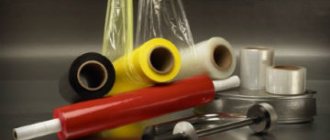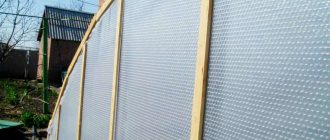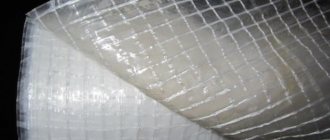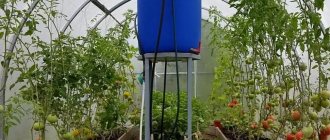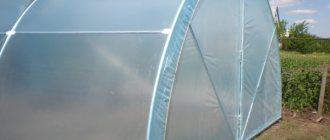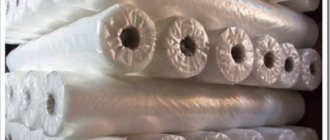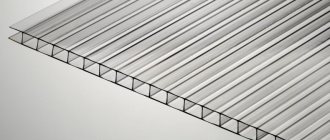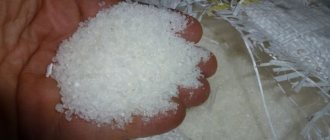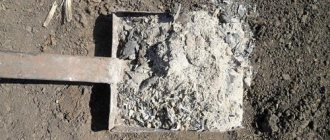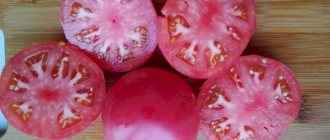A worthy alternative to conventional polyethylene film as a covering for greenhouses is reinforced film. This material retains the properties of conventional films, while having increased resistance to mechanical stress and tearing, and reliably protects against strong winds, hail, heavy snowfalls and low temperatures.
Reinforced film for greenhouses
Advantages of reinforced film
Reinforced film has a number of advantages. Some of them are unique to it, some, on the contrary, are found among all films of this type. We will provide you with the most complete list so that you can immediately decide whether you need reinforced film or whether it is better to pay attention to another material:
- Large throughput. There are films that do not have this quality. Take, for example, bubble film with small bubbles - it does not conduct light well enough, so the film contains additional substances that enhance waves of a certain range and allow plants to receive the light they need for development. Reinforced film can also have a similar characteristic.
- High strength. If in the case of a regular film, the entire load is taken by the fibers of the film, then in the case of a reinforced version, the mechanical load is received by the mesh, which is soldered into the film. Such material can withstand significant mechanical stress without any negative consequences. Even if micro-tears occur, they will not go beyond a certain section of the mesh, and the reinforced film will be able to continue to perform its functions.
Reinforced film is highly durable
- Good insulation. The reinforced film retains the necessary water inside very well, preventing the plants from drying out. However, condensation may accumulate on the inner surface - it is better to remove it so that the plants are not affected by the fungus - this will cause them to grow worse, and you are unlikely to expect a good harvest. At the same time, the film prevents excessive moisture from entering the greenhouse or greenhouse.
- Resistant to temperature changes. Reinforced film can be used in almost any conditions - this is very important, because in Russia the climate is quite unpredictable, and if it was hot during the day, unpleasant frosts with zero temperatures can be expected at night.
- Long life of the material. Reinforced film compares favorably with conventional film due to its increased service life. Its average service life is three years. Of course, everything depends on the specific conditions in which it will be used, plus unforeseen circumstances should be added, but this does not negate the fact of its durability.
The average service life of reinforced film is 3 years
- And lastly, the reinforced film does not delaminate during long-term use . The same can be said about operation after a rupture or puncture - damage will remain minimal.
Some compare reinforced film to tarpaulin or polycarbonate. In principle, the comparison is correct, but reinforced film is essentially a more flexible and lighter material that can be stretched by one person, without the help of familiar or additional devices.
In addition, reinforced film stretches less well, which sets it apart from roll-type materials.
Manufacturing technology of tarpaulin fabric
Relatively recently, a new type of covering material has appeared - tarpaulin. The word "tarpaulin" is translated from English as "tarpaulin". It is made of polyethylene. The production process is reminiscent of fabric manufacturing technology. The threads are intertwined, but not natural, but from fused polypropylene. The threads form a dense base, which is laminated on both sides with opaque polyethylene. The result is a material that is in many ways superior in performance characteristics to tarpaulin and polyethylene used for covering. This is an imported material; it is produced in Turkey, China, Korea, Poland and other countries. The price of tarpaulin is significantly lower than the cost of domestic covering materials.
The fabric has a pleasant blue or green color and has a number of high quality characteristics:
- lightweight, much lighter than tarpaulin;
- hydro- and vapor-tight;
- tear-resistant;
- elastic;
- UV resistant;
- has low cost.
The raw material for the production of tarpaulin is polyethylene, its elongated strips are tightly intertwined and then laminated on both sides
Initially, tarpaulin was used during road works. But almost immediately the scope of its application expanded significantly: awnings began to be made from the fabric. Today there is no worthy alternative or competition for this covering material.
Tarpaulin construction awnings: unlimited use
The main qualities of this covering material make it possible to use it for various industrial, commercial and domestic purposes.
Tarpaulin has different densities. Minimum – 50 g/m². Sugar bags are made from this fabric. For the manufacture of awnings, tarpaulin is used, the density of which is 65 g/m² and higher.
The elasticity of the material allows you to cover objects of various configurations. The awning can be installed on the frame - an excellent temporary shelter will appear. If you connect several awnings, you get a large canvas, with which you can set up a temporary large storage room. Tarpaulin canopies in construction are often used to create canopies, as well as to protect cargo materials during transportation.
Due to its elasticity, tarpaulin can be used to cover construction objects of various configurations.
Helpful advice! As a canvas for covering building materials, you should not choose tarpaulin with a density of less than 120 g/m². Friction against a hard surface is inevitable in this case, and this can significantly reduce the service life of the awning.
The edges of tarpaulin awnings are always additionally reinforced with polypropylene tape soldered inside. Eyelets are inserted into the dense part of the awning (along the edge) at a distance of 1 m from each other. The extreme, corner eyelets, which bear the maximum load, have additional plastic inserts.
Construction tents can have very different sizes. For small parameters, fabric of low density is most often used. For example, a 2x3 m construction awning is made from a material whose density is 65-100 g/m². Usually produced without eyelets and has a budget price. This is a popular option for shelter for a short period of time. In addition to its direct purpose, the awning can be used at home, during camping trips, fishing, where it will serve as a tent or canopy.
Tarpaulin awnings have low cost, light weight and durable structure, and they can also be used at temperatures from -40 ° C to +80 ° C
With dimensions of 4x5 m, the construction awning already has eyelets and is made of denser fabric (from 75 g/m² and above). Although there are also economical options with thin fabric. For large canvas sizes (100 m² or more), reinforced film is used, the density of which starts from 170 g/m².
Tarpaulin awning: positive and negative reviews
The versatility of tarpaulin awnings contributed to the emergence of a significant number of reviews. Quality, cost, appearance are assessed. As for the price, everyone has the right to choose. Almost everyone evaluates the appearance as visually pleasing and aesthetically pleasing. There are different opinions on quality issues.
“From the point of view of water-repellent properties, such an awning is not bad. If fixed well, no dirt will penetrate. But I’ll argue about strength. It doesn't tear, but it's easy to make a hole. I accidentally, without even applying any force, made a hole in the awning with a spatula. Of course, the defect was quickly eliminated and a patch was applied, but the fact of damage remains.”
Sergey Serenky, Maykop
Tarpaulin is characterized by high tensile strength and absolute inextensibility.
“It seems like the eyelets are holding on to nothing. On the first trip, two escaped. And most importantly, they cannot be replaced with the same ones; larger ones are needed. And I’ve never even met anyone like that. There is nothing to replace it with, I’m starting to get used to the holes. Maybe someone can tell me where to look?”
Andrey, Volgograd
“An excellent awning, light, durable, I use it myself, and I give it to everyone who asks. I chose dense, 180 microns. I was looking for the eyelets not to be made of plastic, but metal. Two of them have already been lost. The problem is small, it covers everything with the same quality, it holds up well, but, probably, there was a defect when installing these rings. I even thought about returning the goods.”
Oleg Steiko, Perm
Poorly inserted eyelets are a problem that occurs quite often in reviews. The majority of opinions are positive.
The folded tarpaulin product is distinguished by its compactness and does not take up much space.
“Lightweight, I alone can cope with dimensions of 5x8 m. I’ve been using it for six months, there are no defects anywhere yet. I heard that you need to keep it in the sun less, I take it off and fold it when I don’t need it.”
Evgeny Simonenko, Ekaterinburg
“When they made such a thin roof over my unfinished house, I was skeptical. But the builders were confident in the correctness of their actions, and I just watched silently. Moreover, they connected blue awnings together, making one out of two, ring into ring. At first, I ran to check after every rain. These torpoulin awnings even withstood snow. Now I joke that I want to live under this blue sky.
Elena Postnikova, Yelets.
There are few conflicting reviews about tarpaulin. As a disadvantage, weak eyelets dominate. Users highlight lightness, variety of sizes, price and reliability of protection from precipitation as advantages.
Disadvantages of reinforced film
Despite the significant advantages of reinforced film, it also has a number of disadvantages:
- High price. High-quality reinforced film costs 3-4 times the usual one, which can shake the desire of an ordinary buyer to purchase it.
- Poor throughput. The sun's rays do not pass through this film well due to the presence of a reinforced mesh.
- The need to lift the film for watering. Some materials have additional microscopic holes intended for watering, but ordinary reinforced film is not one of them.
Advantages and disadvantages of the material
Reinforced film is the most popular material for greenhouse decoration.
- And there are reasons for this, since film has many advantages:
- high degree of resistance to ultraviolet rays;
- the ability to create an ideal microclimate inside the greenhouse (constant temperature, optimal humidity);
- ease of operation (if damaged, you can easily replace only the break point; small cracks and holes will not be able to stretch or severely damage the material);
- absence of toxic materials;
- high degree of strength to both mechanical and natural influences.
However, despite the large number of advantages, AP has one significant drawback: due to its density, the film reduces the penetration of light to plants by 12%.
Application of reinforced film
We talked about it only as a material used in the agricultural sector. But that's not the only direction in which people are using this inexpensive material. Reinforced film is also used:
- At home. It is used to compact the bottom of landfills and various artificially created reservoirs - it is excellent for solving such problems due to its high level of waterproofing. Also, reinforced film can be used to ensure the safety of certain elements of landscape design. If you know for sure that there will be hail soon, or if you are just leaving and do not want to see your garden in desolation after returning, stretch the reinforced film and forget about the problems.
Small greenhouse made of reinforced film
- In agriculture. Reinforced film is an excellent option for covering greenhouses of various sizes. With its help, premature rotting of crops is prevented. In addition, due to the high strength of the material, it can easily be used as a temporary canopy. Reinforced film is unlikely to save you from the scorching sun, but it will help a lot from rain or hail.
- In construction. Reinforced film can help out if you need to close doors or doorways during finishing or facade work (often regular film is used for this, but if you need a material of increased strength, you can use reinforced film). It will also be an excellent material for an inexpensive temporary canopy, under which you can drive equipment or hide your team during heavy rain or hail. In some technologies, reinforced film is used for concrete floor screed (as an underlying material). And its last purpose is to ensure the required level of waterproofing when carrying out work of various levels of complexity (especially important when working with a foundation, roof or facade).
Until recently, there was no such clear division, but now many manufacturers offer their customers films designed for a specific application. You may see words or even entire sections in online stores indicating this. Construction reinforced film, agricultural reinforced film, etc. – means that it contains only the additives necessary for each field of activity, which ensure maximum efficiency of the film under the specified conditions at a given minimum price. You won't overpay for features you don't need, purchasing only what will be truly useful.
Installation features
When considering the characteristics of reinforced film, do not forget about the low resistance of the material to mechanical damage. If you handle the canvas ineptly, it’s quite easy to make serious mistakes.
Therefore, it is important to correctly take measurements from the working surfaces and observe the necessary allowances for fixing the cut fragments
When carrying out work on covering greenhouses, it is important to consider the following factors:
• the greenhouse frame must have a smooth surface so that the film does not break through;
• to prevent overheating of the film in hot weather, it is recommended to paint the frame elements with white paint (dark color is known to promote heating);
• protruding parts of fasteners must be hidden under washers or wooden blocks so that sharp parts do not damage the blade.
Production of reinforced film
This is a very important point. Essentially, reinforced film is a mesh of polymers that is laminated with two layers of finished covering material. During the production of laminating film, certain substances can be added to it to improve its characteristics and allow the material to be used in conditions worse than those of conventional film. The layers are securely fastened together, so if you have a reinforced film, you don’t have to worry about it falling apart into its component layers.
Heat-retaining polyethylene
Polymer film
A number of materials have similar properties. First of all, these are the already mentioned air bubble sheets. In them, the temperature is maintained due to the presence of insulated chambers and the large thickness of the covering material. Another design is matte polyethylene films, which have special heat generation properties due to the conversion of ultraviolet rays. Manufacturers achieve this effect by creating complex polymers with many additives. The basis is the same - polyethylene in various combinations, the opacity of the film is given by polypropylene, which has minimal heat transmission capacity.
Advantages and disadvantages:
- Such covering materials have a very short service life at a high price. This is the main disadvantage.
- They are not used for more than one season, but if the greenhouse is year-round, replacement may be required after 7 or 8 months.
- In terms of its strength, it is almost a reinforcing film for large greenhouses; it is quite difficult to tear a thick layer of material. Therefore, installation is not difficult.
- When installing a greenhouse, you need to choose the most sunny place so that the heating will be optimal and the illumination will be optimal. In such greenhouses, the crop ripens approximately 15-20 percent faster, which is why they are often used for industrial purposes.
From an environmental point of view, such durable films for greenhouses are not the most dangerous. They are completely harmless to the environment and decompose faster than many of their analogues, especially in the presence of sunlight. But the material cannot be burned due to the large number of additives, nor can it be buried in the ground.
On a note!
Polyethylene is safe from a fire point of view. It instantly melts without supporting combustion, so it can be used even near the house.
Materials of this type are best suited for year-round greenhouses in which crops are planted in both winter and summer. However, when constructing the frame, it is necessary to provide for the possibility of opening and frequent ventilation. Since the heat does not escape anywhere from the internal space, a ripening effect may occur, which is dangerous for plants.
These properties are directly related to frost resistance. Such films are well suited for covering permanent greenhouses that are not removed for the winter, especially in northern climates. At temperatures down to minus 80 degrees, the film does not “tan” or crack. It loses a little elasticity, so during this period it is better not to perform any manipulations with it, but to wait for at least a little warming up.
Checking reinforced film
Like any other product, reinforced film is subjected to various types of tests. There are certain GOST standards that define all acceptable characteristics for this type of product, and absolutely all manufacturers are obliged to follow it, because otherwise their reinforced film simply will not enter the market - it will be written off as defective.
When testing each batch of film, the prototype must pass the following tests:
- Tear test. A certain force is applied to the film, after which the inspector looks to see whether the material has withstood such a load. The force is strong enough by any standard that if the reinforced film is sitting in a store, it is strong enough (within its capabilities).
- Testing for exposure to various adverse conditions.
- Water resistance testing is carried out separately .
All reinforced film undergoes several quality checks
. Each production has several levels of protection through which each batch of goods must pass before hitting store shelves. Any store you know, including one located on the Internet, has a place where you can get acquainted with suppliers. Any supplier is required by law to go through these levels of verification.
Features of reinforced polyethylene
Now it’s time to familiarize yourself with the technical characteristics of the reinforced shelter:
- wind strength threshold - 34 m/s;
- thermal range -50 to 60 C;
- transmission of light waves - 77%;
Reinforced polyethylene includes three layers:
- reinforcement base (thickness 290-320 g);
- light-stabilized canvas (two layers around the base).
The frame is exposed to the main loads; polyethylene is entrusted with the task of sealing the structure. The frame prevents the film from tearing. You will appreciate this advantage when you pierce a hole in the canvas to secure it to the skeleton of the greenhouse.
Carrying out such manipulations with ordinary polyethylene is a risky business, because it can lead to a violation of its integrity.
Reinforcing polyethylene is not without its drawbacks. It is worth noting that compared to traditional canvas, it transmits 12% less light. The financial side of the issue is also important - coverage will cost more. The material is susceptible to the negative effects of the sun. The service life of low-quality reinforced fabric will be no longer than 7 years.
Types of reinforced film
Experts distinguish two types of reinforced film:
- An ordinary polyethylene film, which was previously reinforced with a fairly strong polymer mesh.
- A special polypropylene non-woven material with an advantageous mesh structure. It is laminated with the polyethylene film already known to us.
In any case, the essence is simple - there is a durable and flexible mesh base, which is laminated with a special film, resulting in a qualitatively new material.
Types of polymers for reinforcement
By double-sided lamination, two outer layers of polyethylene and a layer of reinforcing mesh are bonded together, resulting in a three-layer fabric. When stretched, the strength of polymers increases 4 times. It is stretched polyethylene fibers that are used as a reinforcing mesh - the basis for the strength and tensile ability of the material.
The following types of polymers can be used to make a mesh frame:
- polypropylene
- twisted, pressed or stretched polyethylene
- low-pressure polyethylene
- fiberglass
The cell size ranges from 8x8mm to 20x20mm. The standard width of reinforced film is considered to be the width of the laminator - 2 meters. Samples with a width of 4 meters appeared on the market, which became possible thanks to welding along the entire length of two-meter sheets. The high-quality seam obtained after welding at the fastening point does not reduce the strength and does not spoil the appearance of the product.
Perennial reinforced film
Many sellers very cheerfully use the words “multi-year reinforced film”, but cannot in any way specify what they said. You must clearly understand that without specifying the specific coating that has been improved, you should not purchase the material.
Remember! There are a lot of additives that improve regular film, and you don’t always need all of them specifically.
Get an answer from the consultant (or just look in the characteristics in the online store for the moment you are interested in), and then purchase the material. Below is a list of additives that most often improve reinforced film:
- Hydrophilic additive. Thanks to it, water will not linger on the film, but will immediately flow down the walls to the base. A great option if you know your area gets a lot of rain and your plants don't need excessive moisture. In addition, moisture accumulating on the film can simply tear it over time (the problem is especially acute when using less dense types of film), so such an additive is often extremely important.
- Light stabilizing additive. Thanks to it, the reinforced film will not react so sharply to exposure to sunlight, which will significantly increase the service life of the film. Some people neglect this additive, believing that the sun's rays cannot harm the film so much that its service life will be greatly reduced. However, this is a misconception, and, if necessary and possible, it is better to purchase film with a light-stabilizing additive.
Correct microclimate in the greenhouse
- Heat retaining additive. Thanks to it, the reinforced film retains heat better. This is an ideal option if you need to equip a greenhouse, but the temperature changes in the region are too strong. In this case, such an additive will help save plants from frostbite during night (and not only) frosts.
- Antistatic additive. It prevents dust from settling on the film. For some this is not such an important parameter, but in certain situations it is very important. Firstly, dust partially affects the amount of light transmitted, which means that the plants will receive slightly less heat and lighting, which will have a bad effect on their growth rate and general condition. If you forget to wipe the canopy once, nothing bad will happen, but the constant accumulation of dust on it can have a bad effect on the harvest. In addition, such reinforced film is sometimes used in the construction of various objects, protecting doorways, tools or equipment from dust.
- Light converting additive. Thanks to it, the reinforced film allows only a certain range of waves to pass through, which means that the plants receive only the light they need, amplified several times. Harmful radiation, on the contrary, does not enter the greenhouse.
Such additives can be combined in every possible way - you can easily find on the market the combinations of additives you need in reinforced film. Such coatings can last you up to three years (remember the average three seasons). It is important to ask what kind of reinforced film is in front of you now:
- Seasonal. It cannot be stored in the cold. After the onset of cold weather (not frost), you must carefully fold it and place it in a room with a temperature above zero.
- Annual. This reinforced film can be outdoors all year round without losing its properties.
Manufacturers
The distribution network offers films from Russian and imported manufacturers for sale. For comparison, here are brief characteristics of some production companies and the films they produce.
Zagorsk Experimental Plastics Plant
Films produced in Zagorsk are distinguished by their quality and durability. The threads of the frame layer are made of LDPE monofilament. The film itself is elastic, stabilized against the damaging effects of light, durable and suitable for the construction of greenhouses. ZZZP has launched the production of large-format canvases (up to a width of 6 m). To protect its products from counterfeiting, the company uses special marking of fabrics with red thread.
Reinforced film "ZZP"
Table. Types of markings for two-meter wide films.
| Thickness | Manufacturer's marking |
| Film 120 microns | 3 red threads in the center |
| Film 140 microns | 2 red threads in the center |
| Film 160 microns | 1 red thread along the edge |
| Film 200 microns | 1 red thread in the center |
An interesting special greenhouse film “Red Cell”, which is very elastic and durable, protects plants from ultraviolet rays.
Reinforced greenhouse film from ZZP
LLC TD "Novopolymer"
The company's production workshops are located in Chekhov, Moscow region, the main office is in Moscow, and the branch is in Novosibirsk. They produce reinforced film under the STREN brand, which has already found its admirers.
LLC "TD NOVOPOLYMER"
The reinforcing frame is made of high-strength polypropylene, and the laminating layers include complex additives for resistance to external factors, increasing light transmittance, and mechanical strength. STREN film is capable of operating in the temperature range from -50 to +80°C. A distinctive feature of STRAEN film is the increased size of the mesh cells to 15x15 mm, which further reduces the weight of the film and expands the access of light. What you need for greenhouse coverings.
Reinforced three-layer film STREN (STREN)
Film made in China – “Economy”
Three-layer polyethylene fabric with reinforcing polyethylene mesh. Light-stabilizing additives are not used in production, so the film is used only for temporary structures - outdoors it becomes unusable within just one season. The only advantage of this canvas is its low cost.
Reinforced film "Economy 120"
Reinforced film with light-converting additive
This reinforced film will be an excellent option if you understand that there is not enough light for normal plant growth. It should be used if the climatic conditions of your region are not suitable for the plant that you are going to grow in open ground.
Greenhouse made of reinforced film
It used to be that plants only needed sunlight anyway, but the reality is that plants need different amounts of light in different regions. For example, in southern zones, plants tend to receive too much ultraviolet radiation, which has a bad effect on growth rate and quality of fruiting. By adding a little more ultraviolet converters to the reinforced film, you can restore the balance of sunlight, which will have a positive effect on plants and harvests. In the northern regions, the situation is the opposite - there, for the most part, plants simply do not have enough lighting. Too short a daylight period plus many cloudy days - and now, instead of healthy plants that bear a good harvest, we have stunted sprouts that cannot bear the expected fruits. The situation is improved with special fertilizers, but it is better to solve the problem comprehensively, using, among other things, reinforced film with additives.
The reinforced film should contain phosphors - substances that significantly enhance diffused lighting, allowing plants to receive the necessary dose even on the cloudiest days. Any reinforced film contains these substances, but when working in northern regions, you need to choose a film with a high content of such substances.
Some people refuse to purchase such film because of the rumor that for film with additives it is necessary to purchase additional devices or products. This is not true - it is used in exactly the same way as regular film. Any additional purchases pushed by the seller are not required to be purchased. The main thing is the presence of the necessary additives in the film itself and its characteristics.
In order not to be unfounded, we will give an example of a modern reinforced film produced by our domestic manufacturer. It is known under the names “Biosvet” or “Harvest”. This reinforced film contains additional substances that make it a kind of filter that blocks almost all light waves, making an exception only for waves of a certain range. Thanks to such substances, this reinforced film is used for growing crops that would not normally be able to produce a good harvest in these climatic conditions. This type of reinforced film allows you to control all processes occurring in plants. The absorption of light in greenhouses made of this material exceeds fifty percent - this is one of the best indicators that have ever been achieved. Naturally, this is the maximum indicator, which may decrease depending on different conditions (including climatic ones), but the essence remains the same.
There is also a special film that is used if they want to maintain a good microclimate inside the greenhouse during fairly serious temperature changes outside. It is very good to use in regions where during the day it can be +15...+20 degrees, and at night the temperature drops sharply to almost zero degrees Celsius. Substances are added to such a film that block special waves in the infrared region of the optical spectrum. A small part of the sun's rays does not get inside, and, thanks to this, an ideal microclimate for plants is created in the greenhouse, thanks to which they grow much better and produce a larger harvest.
The solar distribution process is better in a greenhouse
In total, there are two main types of such films, all others are considered their varieties:
- Single layer films. They have one shade, either bluish or reddish.
- Three-layer films. They, on the contrary, have two different shades on different sides - reddish on one, bluish on the other.
Installation
Daily delivery and installation of greenhouses “Volya”
The period of its use and the quality of the harvest depend on the correct installation of the greenhouse. It must create optimal conditions for plant growth and fruit ripening. It should be well lit and protected from the wind.
Choosing a place to build a greenhouse
To install the greenhouse you will need to choose a location. You can focus on the cardinal directions: the sides are turned to the north and south, and the facades are turned to the east and west, or vice versa. The first option is more acceptable; all seedlings will be exposed to full daylight. The peak of photosynthesis will occur before lunch, and the plants will receive the maximum amount of sunlight. If the specifics of growing seedlings do not require this or placing them on plots in this way is not possible, you can choose the second option.
In a situation where the greenhouse will be installed in early spring, it is better to choose a place where the snow melts faster. The shadow of a house or tree should not fall on it; it must also be taken into account that snowdrifts from the roof do not fall onto the building. If the dacha plot is located in a shady area, on a slope or in a depression, or the soil on it is infertile, the instructions for installing a greenhouse must be strictly followed. When the site meets the required conditions, detailed planning of the greenhouse can begin.
Preparatory actions
You will need to clear the area for installation - remove debris, level the surface, there should be no slopes or holes. Places where moisture collects are not suitable, as this disrupts the air exchange in the roots of the seedlings. It is desirable that the soil for seedlings be of the same composition. In places where power structures are installed, it is necessary to compact the soil; it is allowed to create a foundation with concrete or blocks.
If it is planned to install heating for year-round operation of the greenhouse, it should be done before installing the structure. The wooden parts used for installation are treated with an antiseptic to extend service life and reduce the likelihood of rotting.
DIY installation of a greenhouse made of reinforced film
Price for reinforced film
Unfortunately, it is impossible to give the exact price of reinforced film. The problem is that different manufacturers set different prices depending on the number of layers, sizes and additives that a certain reinforced film contains.
The cost of reinforced film can vary from 500 to 13,000 rubles per roll, depending on the characteristics.
If you want to find out the price of the film, you should first decide on the characteristics it should have, then go to the desired section of the store and see how much a roll or square meter costs.
Reinforced film in packaging
Reinforced film is very common, so it can be purchased without any difficulty at any construction (sometimes even hardware) store. If you don’t want to understand all the intricacies, or if you simply don’t have time to scroll through the site or wander around the store, looking for the most suitable options, you should contact a consultant for help.
If necessary, ask the consultant about the availability of film in a certain price range - they will definitely answer you by showing you the options that are most suitable in terms of price and characteristics (or set the appropriate filter in the online store - it’s even easier).
How to use greenhouse film correctly
AP is very easy to use: it is applied directly to pre-installed wooden or metal pipes (frame). The film is secured with self-tapping screws or a construction stapler.
Reinforced material has two sides, and which one to lay is of great importance
When tensioning, it is important to pay attention to the fact that the smooth side should be on the inside
When mechanical damage (holes) appears, it is quite easy to get rid of them: just heat the damaged area with an iron, which will restore the integrity of the coating. However, it is better to prepare a special kit in advance, which in most stores is sold along with a roll of fiber.
Important! The covering must be pulled tightly, but before fastening it is worth loosening it a little to prevent excessive tension. This way the design will more effectively protect plants from wind and rain.
So, when choosing a covering for a greenhouse, you should pay attention to such a useful invention as a three-layer reinforced film. This purchase will save money and time on pulling the base, and will also help protect plants from external factors and create the most optimal microclimate inside the greenhouse
Instructions on how to attach reinforced film to a frame: step-by-step guide
The process of installing reinforced film on a greenhouse differs depending on the type of structure.
Almost all summer residents know how to cover a greenhouse or greenhouse with film, but in addition to the usual frame structures, there are also frameless options.
In order to properly secure the reinforced covering material, it is worth considering each case in detail.
Installation of film on a frame structure
In most cases, reinforced film is used for structures with a frame. In order to quickly carry out installation, you need to follow the instructions:
- Measure out two long wooden slats. Their length should correspond to the length of the greenhouse or greenhouse.
- Unwind the roll with reinforced film a little, attach one of the slats to the edge of the material and, as it were, wrap it in it, making 2-3 turns.
- To ensure that the film holds firmly and does not slip off, you need to secure it to the rail using a stapler along its entire length.
- Next, lay the strip wrapped in reinforced material along one of the edges of the greenhouse and secure it to the base of the frame using self-tapping screws.
- Throw the roll of film over the structure (you will need an assistant here).
- Stretch the film and, having made a slight overlap, place the second strip on it, and then attach it to the film with a stapler.
- Secure the second wooden strip to the base of the frame with self-tapping screws.
- Trim the remaining film with a knife or scissors.
- Fix the film over the entire frame.
Film covering for greenhouses and greenhouses is used quite often, this is due to its simple installation and affordable cost.
Construction of a frameless greenhouse
The simplest option for sheltering plants is frameless greenhouses, constructed by covering the ground with film (in this case reinforced).
This material is considered more preferable than conventional film because it is heavier and has high performance characteristics.
Installing a frameless greenhouse is quite simple and quick:
- Cover the bed with the selected material immediately after sowing the seeds.
- Securely secure it on the sides with heavy objects (you can use stones).
- If, when organizing a bed, you build ridges along the edges, then seedlings or early herbs can be grown under the film. In this case, a frame is not required, since the film will sag slightly.
Frame structures are also considered a good option for a frameless greenhouse. To build them, you will need to place wooden blocks around the perimeter of the bed. A reinforced film is attached to them using a stapler.
Frameless greenhouses are usually built in early spring, so a material that can easily support them is suitable. Reinforced film belongs to such products.
How to replace reinforced film
It is believed that there are many materials that can be used as reinforced film, such as polycarbonate. On the one hand, this is true, but on the other hand, not everyone can afford to buy such materials. Take, for example, the average agrotextile. Few people know about it, but if you remember that it costs much higher, then ordinary reinforced film appears in a good light.
Agrotextiles
Ordinary polyethylene film, as we have already said, is cheaper than reinforced film, and in certain cases its capabilities are enough not to overpay. However, it is worth remembering that it is less durable and versatile.
3.7/5 — (3 votes)
Release form
The film comes out of the conveyor in rolls of various widths and lengths. Standard roll sizes are shown in the table.
Reinforced film is available in rolls
Table. Standard sizes of reinforced film for greenhouses.
| Density g/m2 | Width, m | Length, m |
| 140 | 2, 3, 4, 6 | 10, 25, 50 |
| 200 | 2, 3, 4, 6 | 10, 25, 50 |
| 250 | 2, 3 | 10, 25, 50 |
| 300 | To order | To order |
For reference. When purchasing, read the certificate of conformity for the product and read the storage conditions. Do not purchase rolls with damaged packaging - the canvas inside may be damaged.
For ease of transportation, wide webs are folded into several layers before winding - three-meter sheets in half (the roll has a height of 1.5 m), and six-meter sheets - in three layers (the roll has a height of 2 m).
Content:
- Reinforced polyethylene film 2x10m 200µm ZZP covering, for greenhouses, greenhouses, light-stabilized, food grade, light transmission 81%, mesh cell 12x12mm
- Reinforced greenhouse film 2x25m 140g/sq.m 200mkr TDStels
- Reinforced greenhouse film 2x50m 120g/sq.m 200mkr TDStels
- Reinforced film 120 MKR - (2X12 M)
- Reinforced greenhouse film 140g/sq.m. (2x50m) 200 microdistrict TDStels
- Reinforced greenhouse film 2x20m 120g/sq.m 200mkr TDStels
- Reinforced film 150 MKR - (2X12 M)
- Reinforced film 400 microns
- Reinforced film 120 g (4x50)
- Reinforced film 100 g (2x25)
- Which reinforced film is best to use for a greenhouse?
Reinforced greenhouse film 140g/sq.m. (2x50m) 200 microdistrict TDStels
Photo: beru.ru
Reinforced polyethylene film has decent performance qualities. It has high light transmittance, as well as low vapor and moisture permeability. The product is also resistant to fungi and mold. The product is also resistant to deformation and durable if you follow the operating rules correctly.
Reinforced greenhouse film 140g/sq.m. (2x50m) 200 microdistrict TDStels
Pros:
- UV resistance
- high strength
- rot resistance
- weather resistance
- environmental friendliness
- creating a microclimate
- possibility of quick repair
- ease of storage
- density 140 g/m2
- guarantee
- certificates
- all types of payment
Reinforced greenhouse film 2x50m 120g/sq.m 200mkr TDStels
Photo: beru.ru
Reinforced film is presented on the market by Russian and foreign manufacturers. The product is characterized by high performance and quality properties. In demand as a covering and waterproofing material. Still unsure which reinforced film to choose for greenhouses? We recommend choosing the TDStels product.
Reinforced greenhouse film 2x50m 120g/sq.m 200mkr TDStels
Pros:
- UV resistance
- high strength
- rot resistance
- weather resistance
- environmental friendliness
- creating a microclimate
- possibility of quick repair
- ease of storage
- density 120 g/m2
- guarantee
- certificates
- all types of payment
Some installation tips
- To install the film covering correctly and avoid mistakes, you need to carefully inspect the frame of the greenhouse . It is unacceptable to begin installation of the coating if there are sharp or strongly protruding parts or edges. The greenhouse for reinforced film must be prepared in advance.
- It is better to choose a light frame color, because... a dark-colored frame will heat up very strongly under the rays of the summer sun, which can lead to thermal damage to the film.
- When attaching the shelter to the frame, use only self-tapping screws.
- If the area of the greenhouse is small , then you can choose film material with a thickness of 140 microns. Such material will be quite resistant to ultraviolet rays, but will not be able to withstand loads. It is better to dismantle it by winter.
- When purchasing reinforced film, pay attention to the color of the product . For greenhouses, white and blue will be the most suitable. In certain conditions, green is also considered acceptable. A yellow tint will not be suitable for growing plants. But the blue color is typical for construction reinforced coatings or waterproofing.
- Products from Korean manufacturers are usually made of polyethylene , and Danish ones are made from polypropylene. The width of the reinforced film ranges from 2 to 6 meters.
Return to content
